One of the trees displayed at Bay Island Bonsai’s 13th annual exhibit got a lot of funny looks. It’s a Rocky Mountain juniper, Juniperus scopulorum.
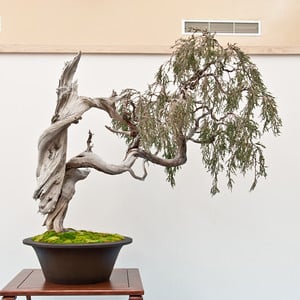
Rocky Mountain Juniper
It’s not exactly “show-ready” as we like to say – the tree is only a few years out of the ground and branch pads have yet to be defined. The tree offers, however, a glimpse of how floppy the tree’s foliage can be and plenty of interesting deadwood. Maybe too interesting. The large piece of deadwood on the left looks like something an undiscerning artist found on the ground and affixed to the first tree they dug. It is, however, very naturally connected to the live part of the tree.
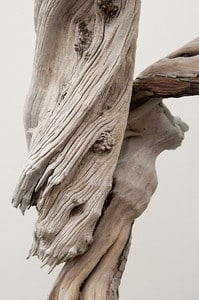
Old deadwood – evidence of an older, larger tree
If you look closely, you can easily discern the old deadwood from the new. The deadwood supporting the live part of the tree lacks the deep fissures evident on the big jin. In the photo below, the upper part of the deadwood is light in color with subtle fissures. This wood has been exposed to the elements for a while, but not for as long as the jin on the left. The lower part of the deadwood is darker in color and lacks fissures. This wood has more recently been exposed to the elements.
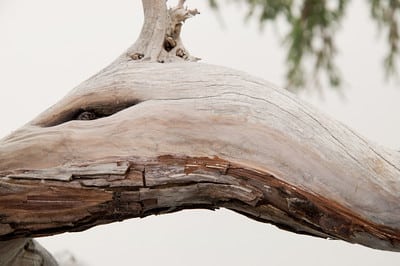
Older and newer deadwood
A few days before the exhibit, I cleaned the tree’s deadwood with a water gun and then treated it with a mixture of lime sulfur, water and sumi ink. This helped to even out the different tones of deadwood on the tree. A new pot and some bright moss completed the show prep.
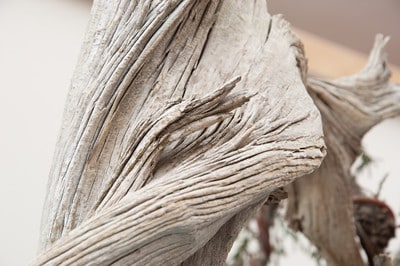
Rocky Mountain Juniper deadwood
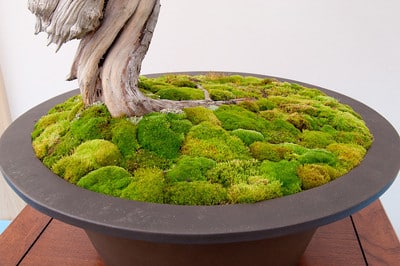
Moss
Why so much effort for a tree that’s not quite ready for display? Interesting deadwood, great age, and curious foliage contributed to the decision. Beyond that, the tree offers a great puzzle for aspiring bonsai stylists. In other words, what improvements can be made to the tree? There are plenty of alternatives. It’s the kind of tree I’d like to walk by in the garden for a while before making up my mind. Although I don’t know what exactly is in store for the tree’s future, I do know it will look quite different the next time I see it in an exhibit.
Subscribe to Bonsai Tonight
New Posts Delivered Every Tuesday and Friday
Dale Brock says
Your right about it’s potential. If you like this type of Juniper, you should consider looking at Ryan Neil’s website. RMJ’s have become one of Ryan’s specialties. I believe even Kimura would be impressed with his apprentice.
Great article! It definitely teases the brain on the tree’s potential.
Darth Tanuki says
I found this tree uncomfortable to see in the show. Do you think it may be condoning, enabling or justifying putting trees in a show that are not ready? Perhaps lowering the bar for small time club shows with an example of less to aspire to. Especially when we youngins with newfangled ideas try to convince the ‘old timers’ or naturalistic enthusiasts that a clean formal or semi formal show is something to aspire to.
John says
The concept of a weeping juniper was quite actively discussed as Jonas worked on the tree and we talked about the type of pot to use. I believe the tree was ready if you view it as a weeping specimen. Using your limited view of the Universe, Darth, I can understand your position.
Roger says
Its great. Inspiring in fact. Its about art and the ability to see what could be in time. Its intrinsic value is great to start with. Smiles to you and thanks for the post.
Marty says
At first, I thought what an interesting wisteria with such exceptional deadwood. Today our study group spent the day on drawing exercises with an emphasis on drawing what you really see and getting rid of your preconceptions. If you see this as a “juniper that is not ready for show” then you are letting your preconceptions of juniper bonsai bias your view. If you open your mind to permit alternative foliage forms then we have a very interesting, perhaps even slightly bizarre, sculptural bonsai reminiscent of some of Kimura’s more sculptural bonsai.
brendenstudio says
I have to say this tree caused me to do a double-take when I saw it in the line up for the show. I’ve got a few RMJ’s I’ve collected and most of them have foliage like this one when it’s allowed to grow unchecked. I’ve entertained keeping one in the weeping style and cutting it back only when necessary. I think the tree shown looks quite good this way and is certainly unique and not what is expected when one sees juniper bonsai. It might be worth considering keeping it in a weeping style.